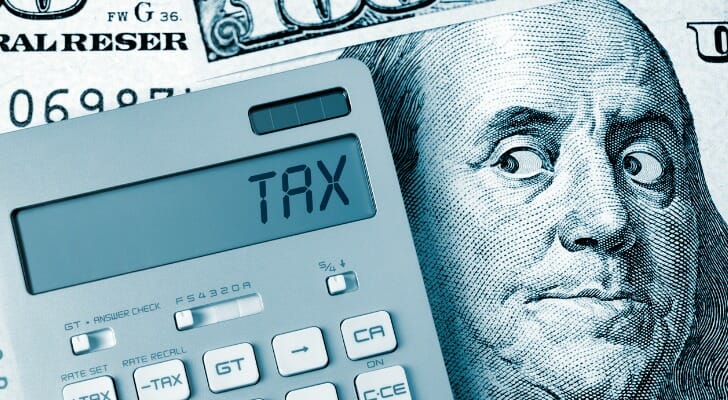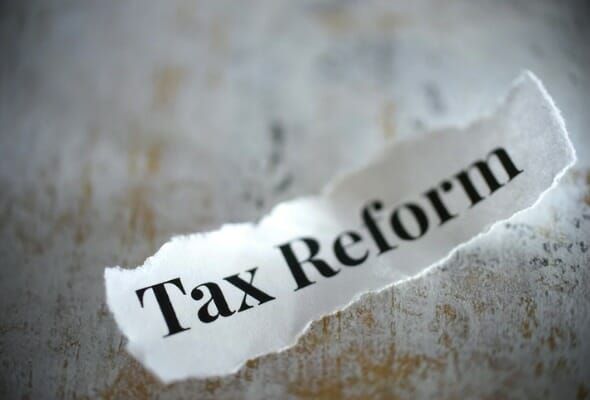President Donald Trump signed the One Big Beautiful Bill Act into law on July 4, delivering an estimated $4.5 trillion in tax cuts. The legislation locks in the 2017 individual tax brackets permanently and introduces new deductions for tips, overtime pay and seniors. However, the measure is expected to add $4.1 trillion to the federal deficit by 2034, according to the Congressional Budget Office. 1 It also cuts Medicaid by nearly $1 trillion and trims billions from the Supplemental Nutrition Assistance Program (SNAP). The final version passed the House by a razor-thin 218–214 margin after changes were made in the Senate.
Do you have questions about how these changes could affect your taxes? Speak with a financial advisor today.
How Does Trump’s Tax Plan Affect Your Tax Bracket?
With President Trump’s signature on the One Big Beautiful Bill Act, the current marginal tax rates are now permanent. These tax brackets, first enacted under the 2017 Tax Cuts and Jobs Act (TCJA), were previously set to expire after 2025. Without the new law, federal income tax rates would have reverted to their pre-2018 levels, when the top marginal rate was 39.6%, potentially increasing taxes for many households.
Want to see how Trump’s tax plan could impact you? Read our full overview here.
What Are the Current U.S. Tax Brackets?
There are currently seven marginal tax rates in place, ranging from 10% to 37%. Marginal tax rates apply only to the portion of your income that falls within each tax bracket, not to your total income. To determine your marginal tax rate, find the highest tax bracket that includes part of your taxable income.
Here’s a breakdown of the brackets in 2025 and 2026:
2025 Federal Income Tax Brackets
| Tax Rate | Single | Married Filing Jointly | Married Filing Separately | Head of Household |
|---|---|---|---|---|
| 10% | $0 – $11,925 | $0 – $23,850 | $0 – $11,925 | $0 – $17,000 |
| 12% | $11,925 – $48,475 | $23,850 – $96,950 | $11,925 – $48,475 | $17,000 – $64,850 |
| 22% | $48,475 – $103,350 | $96,950 – $206,700 | $48,475 – $103,350 | $64,850 – $103,350 |
| 24% | $103,350 – $197,300 | $206,700 – $394,600 | $103,350 – $197,300 | $103,350 – $197,300 |
| 32% | $197,300 – $250,525 | $394,600 – $501,050 | $197,300 – $250,525 | $197,300 – $250,525 |
| 35% | $250,525 – $626,350 | $501,050 – $751,600 | $250,525 – $626,350 | $250,525 – $626,350 |
| 37% | $626,350+ | $626,350+ | $578,125+ | $626,350+ |
2026 Federal Income Tax Brackets
| Tax Rate | Single | Married Filing Jointly | Married Filing Separately | Head of Household |
|---|---|---|---|---|
| 10% | $0 – $12,400 | $0 – $24,800 | $0 – $12,400 | $0 – $17,700 |
| 12% | $12,400 – $50,400 | $24,800 – $100,800 | $12,400 – $50,400 | $17,700 – $67,450 |
| 22% | $50,400 – $105,700 | $100,800 – $211,400 | $50,400 – $105,700 | $67,450 – $105,700 |
| 24% | $105,700 – $201,775 | $211,400 – $403,550 | $105,700 – $201,775 | $105,700 – $201,750 |
| 32% | $201,775 – $256,225 | $403,550 – $512,450 | $201,775 – $256,225 | $201,750 – $256,200 |
| 35% | $256,225 – $384,350 | $512,450 – $768,700 | $256,225 – $384,350 | $256,200 – $640,600 |
| 37% | $384,350+ | $768,700+ | $384,350+ | $640,600+ |
The dollar ranges for each federal income tax bracket are adjusted annually for inflation. The IRS updates these thresholds each year based on changes in the Chained Consumer Price Index, so the income ranges typically increase slightly to reflect cost-of-living adjustments.
For example, someone who earned $105,000 in 2026 would have been in the 24% tax bracket. However, thanks to the annual inflation adjustment, the same $105,000 salary in 2026 puts them in the 22% tax bracket, which tops out at $105,700 for single filers.
Check out our in-depth study to learn more about how the One Big Beautiful Bill Act (OBBBA) impacts Americans across the country.
What Would’ve Happened if the Current Tax Brackets Expired?
If Congressional Republicans didn’t advance Trump’s tax plan, the current tax brackets would have expired and reverted to their pre-2018 levels when the marginal tax rates were: 10%, 15%, 25%, 28%, 33%, 35% and 39.6%. Keep in mind that the income ranges for each tax bracket wouldn’t revert to 2017 levels, but rather just the rates.
If the TCJA provisions expired, many taxpayers could face higher marginal tax rates. For example, a single filer earning $50,000 in taxable income in 2026 would fall into the 12% marginal tax bracket. However, under the pre-TCJA rates projected for 2026 by the Tax Foundation, 2 that same income would place them in the 25% bracket. Similarly, a married couple filing jointly with $120,000 in taxable income may have moved from the 22% bracket to the 25% bracket if the TCJA rates weren’t extended.
The legislation also permanently raises the federal estate and lifetime gift tax exemption. Previous rules would have reduced the current exemption ($13.99 million in 2025) sharply at the end of 2025. Now, regardless of when gifts were previously made, that exclusion carries forward under the higher threshold ($15 million in 2026).
What Else Does the Trump Tax Plan Do?

After weeks of deliberation, Senate Republicans passed their version of the One Big Beautiful Bill on July 1, even as three GOP senators opposed it. Sens. Rand Paul (Kentucky), Susan Collins (Maine) and Thom Tillis (North Carolina) joined Democrats in voting against the measure, resulting in a 50–50 split that required Sen. Vance to cast the tie-breaking vote. At the time, Republicans held a 53–47 majority over Democrats and independents in the Senate.
Once the Senate approved the bill, it returned to the House for a final vote on July 3. Ultimately, only two Republicans, Thomas Massie of Kentucky and Brian Fitzpatrick of Pennsylvania, voted against it alongside Democrats.
In addition to making the current income tax brackets permanent, Trump’s tax plan includes several changes to deductions and credits. Below is an overview of the key components.
Increased SALT Deduction
Under the 2017 Trump tax law, the SALT deduction was capped at $10,000 ($5,000 for married filing separately), limiting the amount taxpayers could deduct for state and local income, property, or sales taxes. Before this law, itemizing taxpayers could fully deduct these taxes, which especially benefited residents in high-tax states.
Big changes to the SALT deduction are taking effect: See what they could mean for you.
The House initially proposed raising the SALT cap from $10,000 to $40,000 ($20,000 for separate filers) in 2025. It would have then increased incrementally each year through 2033, at which point it would stop rising and remain permanently fixed. Under that plan, the higher deduction would begin to phase out for incomes above $500,000 ($250,000 if married filing separately).
However, the SALT deduction limit rises more modestly under the final version of the bill. Republicans in the House and Senate ultimately agreed to increase the SALT deduction to $40,000 in 2025 and then by 1% each year through 2029. Then, the cap reverts to $10,000 in 2030 and beyond. In 2026, the deduction increases to $40,400.
Raising the Standard Deduction
Both the House and Senate bills extend the enhanced standard deduction introduced by the TCJA and add a temporary increase for tax years 2025 through 2028. For tax year 2025, single filers can claim $15,750; married couples filing jointly get $31,500; and head‑of‑household filers receive $23,625. These figures will then adjust annually for inflation.
In 2026, the standard deduction rises to $16,100 for single filers, $32,200 for married couples filing jointly and $24,150 for heads of household.
Not sure if you should itemize or take the standard deduction in light of recent tax changes? Consider speaking with a financial advisor about your tax strategy.
Deductions for Tips and Overtime
The Senate bill kept House exemptions for tips and overtime. The legislation allows taxpayers to deduct both tips and overtime pay from federal taxable income. Tips must be cash-based, voluntarily paid and earned in occupations where tipping was customary before 2025. The deduction excludes tips received in specified service trades or by high-income earners.
For overtime, the deduction applies to pay above the regular rate as defined by the Fair Labor Standards Act. Highly compensated employees are excluded. Both deductions would be available to non-itemizers and require valid Social Security numbers.
Child Tax Credit
The Child Tax Credit will increase under the legislation, rising to $2,200 for 2025 and 2026, with indexing starting in 2026. The House version of the bill originally increased the credit to $2,500.
Enhanced Deduction for Seniors
Under the legislation approved by both chambers, individuals aged 65 and older receive a $6,000 “senior bonus” deduction beginning in 2025. That amount phases out at a rate of 6% once modified adjusted gross income (MAGI) exceeds $75,000 for singles and $150,000 for joint filers.
This is a revision of the initial proposal, which would have offered a $4,000 senior deduction, phasing out at 4% over the same income thresholds. The higher $6,000 benefit reflects Senate adjustments during the reconciliation process. A valid Social Security number is required to claim the deduction.
Impact of Trump Tax Plan
While the Trump administration projects significant economic growth, many economists and fiscal analysts are expressing concerns about its long-term fiscal implications.
Various estimates suggest that the legislation will add trillions to the national debt over the next decade. For example, the nonpartisan Congressional Budget Office (CBO) initially projected that the tax and spending plan would add $3.4 trillion to the country’s deficit between 2025 and 2034. 3 However, the CBO has since updated its projection to account for the estimated $718 billion in debt-service costs the legislation will add. The Penn Wharton Budget Model, a nonpartisan research initiative that analyzes the impact of fiscal policy, estimates the plan will add $3.2 trillion to the deficit in the next 10 years. 4
Surging debt has already contributed to a downgrade of the U.S. credit rating by Moody’s, reflecting concerns over fiscal sustainability.
Who Benefits the Most?
The benefits of the tax cuts are expected to be unevenly distributed. High-income earners and corporations are likely to see the most significant gains, while middle-income workers may experience modest relief.
The Penn Wharton Budget Model projects that low-income households would see an overall financial loss from the law. By 2030, cuts to programs like Medicaid and SNAP would outweigh any tax savings for households earning less than $53,000 or less. In contrast, the top 10% of households would capture the majority of the legislation’s total benefits, with about 80% of its overall value flowing to this group.
For context, here’s how the signed bill is expected to impact the after-tax income of households across the economic spectrum:
| Income Group | Average Change in After-Tax-and-Transfer Income in 2030 | Median % Change in After-Tax-and-Transfer-Income in 2030 |
|---|---|---|
| $0 – $18,000 | -$885 | -5.4% |
| $18,000 – $53,000 | -$1,090 | -2.3% |
| $53,000 – $96,000 | $45 | +0.1% |
| $96,000 – $179,000 | $2,505 | +1.7% |
| $179,000 – $272,000 | $4,625 | +1.9% |
| $272,000 – $401,000 | $6,805 | +1.9% |
| $401,000 – $1,020,000 | $17,275 | +2.7% |
| $1,020,000 – $4,451,000 | $27,195 | +1.5% |
| $4,451,000+ | $72,885 | +0.5% |
The Institute on Taxation and Economic Policy (ITEP)—a left-leaning economic think tank—offered similar conclusions. The ITEP estimates that more than 70% of the tax cuts under Trump’s plan in 2026 will go to the top 20% of households. Meanwhile, the richest 1% of households will receive $117 billion in tax cuts in 2026, which is approximately 52% more than the the bottom 60% of all households will receive ($77 billion), according to the ITEP analysis. 5
Social Program Cuts
To offset some of the tax cuts, the bill proposes significant reductions in social safety net programs. According to the CBO, nearly $1 trillion will be cut from Medicaid, potentially leading to nearly 12 million people losing health insurance. Meanwhile, another $186 billion in funding cuts will be made to nutrition programs, including SNAP benefits over the next decade.
Effect on GDP
The White House projects that the bill will boost gross domestic product (GDP) by up to 5.2% in the short term and increase wages significantly. However, independent analysts are skeptical, projecting a more modest GDP increase and warning that long-term benefits may not materialize. The Penn Wharton Budget Model, meanwhile, estimates that GDP will fall by 0.3% and the average wage will drop 0.4% in 10 years, as a result of the legislation.
How the Trump Tax Brackets Passed
Trump and Johnson narrowly secured House Republican support for the bill, which passed by a margin of 215-214 on May 22. Only two Republican representatives voted against the legislation, with another voting “present.”
The legislation faced a similarly thin margin in the Senate, requiring Vance to cast the tie-breaking vote on July 1. Trump had called on Congressional Republicans to pass the bill and have it on his desk to be signed by July 4.
Among Republicans, fiscal conservatives had previously expressed concerns about the bill’s projected addition of trillions to the national debt. They have demanded deeper and more immediate spending cuts, particularly to programs like Medicaid and green energy subsidies.
When asked by CNN how many Republican senators share his concerns about the bill’s impact on the national debt, Sen. Ron Johnson (R-Wisconsin) said: “I think we have enough to stop the process until the president gets serious about spending reduction and reducing the deficit.”
Meanwhile, other Republicans expressed apprehension about the bill’s cuts to Medicaid, including Sens. Susan Collins (R-Maine) and Josh Hawley (R-Missouri).
“I am looking very carefully at the Medicaid provision, and in particular, I’ve been very concerned about the impact on children, on people with disabilities, on seniors who are eligible for both Medicare and Medicaid, and for low-income families,” Collins told WMTW in Maine.
“Republicans need to open their eyes: Our voters support social insurance programs. More than that, our voters depend on those programs,” Hawley wrote in a May 12 op-ed in the New York Times.
Ultimately, though, Hawley and Johnson voted for the bill, which cuts over $900 billion from Medicaid and will result in an estimated 11.8 million losing their health insurance. Collins was one of three Republican senators to oppose it.
Democrats unanimously opposed the plan, criticizing it for favoring the wealthy while proposing cuts to social safety net programs. They argued that the bill’s tax cuts disproportionately benefit high-income earners and corporations, while reductions in Medicaid and SNAP would harm vulnerable populations.
Bottom Line

The passage of the One Big Beautiful Bill Act preserves the current income tax brackets beyond 2025, preventing a return to the higher pre-2018 rates. Marginal rates from 10% to 37% will continue to apply, shaping how various portions of income are taxed in future years. While extending the 2017 brackets maintains lower tax rates for many households, it is projected to increase the federal deficit by an estimated $4.1 trillion over the next decade.
Tax Season Tips
- You may be able to take advantage of tax minimization strategies by working with a financial advisor who offers tax planning. Finding a qualified financial advisor doesn’t have to be hard. SmartAsset’s free tool matches you with financial advisors who serve your area, and you can have a free introductory call with your advisor matches to decide which one you feel is right for you. If you’re ready to find an advisor who can help you achieve your financial goals, get started now.
- See if you’ll be getting a refund or if you’re likely to have to send a check to the government by using SmartAsset’s tax return calculator. This can be useful for your household budget. Plus, it helps you know what to expect when you go through with actually filing.
Photo credit: ©iStock.com/Kameleon007, ©iStock.com/hamzaturkkol, ©iStock.com/wutwhanfoto
Article Sources
All articles are reviewed and updated by SmartAsset’s fact-checkers for accuracy. Visit our Editorial Policy for more details on our overall journalistic standards.
- “Effects on Deficits and the Debt of Public Law 119-21 and Related Debt-Service Costs.” Congressional Budget Office, 4 Aug. 2025, cbo.gov/system/files/2025-08/61466-DebtService.pdf.
- Hulehan, Kyle. “How Tax Brackets Would Change If the TCJA Expires.” Tax Foundation, 24 Oct. 2024, https://taxfoundation.org/blog/2026-tax-brackets-tax-cuts-and-jobs-act-expires/.
- “Estimated Budgetary Effects of Public Law 119-21, to Provide for Reconciliation Pursuant to Title II of H. Con. Res. 14, Relative to CBO’s January 2025 Baseline.” Congressional Budget Office, 21 July 2025, https://www.cbo.gov/publication/61570.
- “President Trump-Signed Reconciliation Bill: Budget, Economic, and Distributional Effects — Penn Wharton Budget Model.” Penn Wharton Budget Model, 8 July 2025, https://budgetmodel.wharton.upenn.edu/issues/2025/7/8/president-trump-signed-reconciliation-bill-budget-economic-and-distributional-effects.
- “Analysis of Tax Provisions in the Trump Megabill as Signed into Law: National and State Level Estimates.” ITEP, 22 July 2025, https://itep.org/tax-provisions-in-trump-megabill-national-and-state-level-estimates/.
